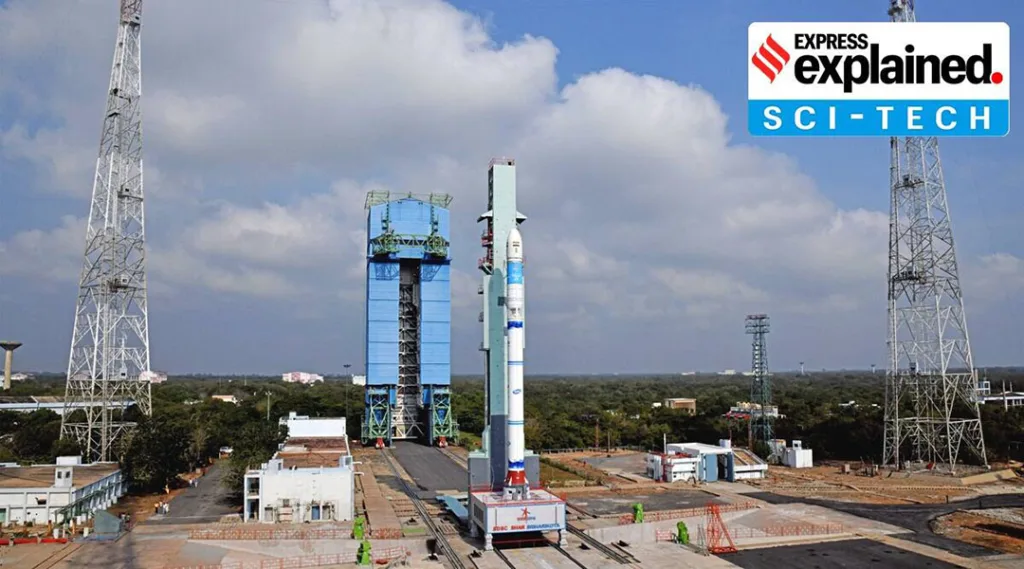ISRO SSLV-D2 rocket launch: Scheduled for 9.18 am, the launch mission was successful and lasted around 15 minutes. It was ISRO’s first launch of 2023.
In its second development flight on Friday (February 10) morning, the Small Satellite Launch Vehicle (SSLV-D2) was launched successfully from the first launch pad at the Satish Dhawan Space Centre SHAR, Sriharikota, Andhra Pradesh. It will place the Indian Space Research Organisation (ISRO) earth observation satellite EOS-07 and two co-passenger satellites — Janus-1 and AzaadiSat2 — developed by start-ups, in a 450-km circular orbit around the Earth.
The mission of ISRO’s smallest vehicle — scheduled for 9.18 am — lasted around 15 minutes. It was ISRO’s first launch of 2023.
What’s the aim of the launch?
The new vehicle was developed to capture the emerging small and micro satellite commercial market, with launches offered on demand. The rocket can be assembled by a small team in only a few days, compared to the six months and around 600 people it takes for ISRO’s workhorse PSLV.
“Our plan is to make it available in a week’s time — the assembly can be done in two days, [followed by] two days of testing, and the next two days we are doing the rehearsal and launch. We have already done that this time,” ISRO chairman S Somanath had told The Indian Express earlier.
This is the second attempt at a launch. What happened the last time?
The launch vehicle uses three solid stages followed by a liquid-fuel-based Velocity Trimming Module (VTM) to place satellites in orbit. The vehicle’s first development flight that took place last August after repeated delays due to the pandemic, failed to place the satellites in precise orbit.
This was because of excessive vibration sensed by accelerometers during the second stage separation, which made the on-board system ‘think’ that the sensors were faulty. For the second flight, structural changes have been made to the equipment bay, along with changes in the separation mechanism for stage 2, and logic changes for the on-board system.
A new vehicle is declared operational by the space agency after it completes two successful development flights. The last vehicle to be declared operational was the GSLV Mk III, now called LVM 3, when it carried Chandrayaan-2 in 2019.
What is Janus-1?
Janus-1 is a technology demonstrator satellite built by United States-based Antaris and its Indian partners XDLinks and Ananth Technologies.
“We are creating a standardised satellite bus on which multiple payloads can be attached just like lego blocks. This will enable companies to quickly and cheaply launch their payloads. Once launched, we can handle the operations for them or give the companies access to our platform so that they can control it. We are making in India for the world,” Rupesh Gandupalli, CEO of Xdlinx, said.
A satellite bus is the main structure of a satellite on which the payloads — which can be used for multiple applications such as earth observation, signal monitoring, or ship tracking — rest. The company aims to make satellite buses of different sizes, for satellites weighing around 100 kg.
Janus-1, which weighs only 10.2 kg, is a six-unit cube satellite with five payloads on board — two from Singapore, and one each from Kenya, Australia, and Indonesia. The entire satellite was built in 10 months, less than half the time it usually takes to manufacture satellites of this size, according to Gandupalli.
And what is AzaadiSat2?
The payloads have been built by 750 girl students from across India. A similar satellite by SpaceKidzIndia was launched aboard SSLV-D1 in August last year. The payloads remain the same — LoRa amateur radio, a sensor to measure radiation levels in space, and sensors to measure the health of the satellite such as temperature, reset count, and inertial data — but this second satellite has an additional feature.
SpaceKidzIndia — which aims to promote space awareness among children — has made the satellite expandable: the 8-unit satellite will have a spring mechanism-based external frame, which will open up once the satellite is in orbit. After the frame opens up, the satellite will become four times its size.
“This external frame will host a new cheaper type of solar panels to provide energy to the satellite. Energy for sustaining longer durations in space is one of the challenges of the small satellites, which is why we have made the structure expandable. This is the first time such a thing is being tried out,” Srimathy Kesan, founder and CEO of SpaceKidzIndia, said.
“The small size at the time of launch with a bigger power pack means the satellite will easily fit in the launch vehicles, and start-ups will spend less on launch services,” she added.
One hundred and fifty of the 750 students who developed some of the payloads will be in Sriharikota to witness the launch on Friday. “When the satellite failed to reach orbit last time, the children took it in their stride,” Kesan said The satellite will also carry the G20 logo to space and the NCC song to celebrate 75 years of the organisation; Kesan herself was the best cadet from Andhra Pradesh in 1992. The “space song” about girl children and students of rural India dreaming of becoming space scientists, has been composed by Devi Sri Prasad, popularly known as DSP.
Courtesy : The Indian Express
